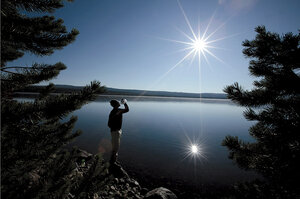The greening of the West
Long the province of mountain men and rugged individualists, the Intermountain West is drawing a new generation of entrepreneurs, knowledge workers, and venture capitalists keen on experiencing the region's natural wonders while staying connected to the global economy.

Hiking near Heart Lake at Yellowstone National Park in Wyoming.
Lucy Nicholson/Reuters/File
West is just a point on the compass, there to the left as you face north. But throughout history, the west has been associated with freedom and fresh starts. Explorers, dreamers, iconoclasts, and opportunity seekers have always followed the sun. The west has tugged at the imagination since the earliest epochs of Indo-European migration.
The torch of civilization was relayed from Persia to Greece to Rome. Though it dimmed for a few hundred years, it again moved westward with the Renaissance and Reformation. Then it was on to the New World and the westward push of pioneers. In the decades ahead, the handover is likely to stretch across the Pacific toward the economic powerhouses of Asia.
The West that we look at in a Monitor cover story is the one embedded in the American mind, the one captured by Albert Bierstadt, Frederic Remington, and Ansel Adams with their images of the almost impossibly beautiful Rockies, Tetons, and Pacific Northwest. Todd Wilkinson, who has written covers for us on the return of wolves and the rise of the green ranching in that region, now surveys its robust economy and its green ethos.
Once merely gorgeous, isolated, and quaint – primarily valued only for minerals, timber, and recreation – the Intermountain West is now attracting innovators, venture capitalists, and knowledge workers who love the idea of trout fishing, mountain biking, and blasting down black-diamond slopes when they aren’t teleconferencing with Shanghai and London.
Rugged individualists have made their way to the region for generations, real-life versions of the Jeremiah Johnson character Robert Redford played. Being self-sufficient and cut off from the outside world was not just the norm, it was the whole point. But connectivity has changed that. Now you can have the serenity of a clear blue mountain lake but still have access to the digital cloud and the global economy.
Like any quest for happiness, however, the growing popularity of the Intermountain West has its “yes, buts.” The British philosopher Jeremy Bentham termed the human quest for beauty and pleasure – and the desire to have more and more of it – the “felicific calculus.” If you like that view, how about having it every day? Enjoy trout fishing on vacation? Why not trout fish before you go to work?
The problem is that as more humans run their felicific calculations and decide to live in pleasant places, their presence changes the balance. An old-timer grumbled when you arrived 20 years ago. Now a thousand new arrivals are ruining paradise for you. This isn’t just a perspective problem. The New World after Columbus was conquered, exploited, and despoiled. Careless rushes for land, gold, and energy resources have left scars on wilderness throughout the world.
Will the Intermountain West be different? Maybe. As you’ll see in Todd’s report, the conservation/environmentalism ethic runs deep in the region. It cuts across the lines of politics, business, and even the traditional divide between old-timer and new arrival. Almost everyone is running the same calculation. Almost everyone wants economic and environmental balance.
The difference this time – the thing that may make the Intermountain West sustainable – is a powerful desire to keep alive the West of our imagination.

